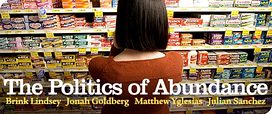As I mentioned in my previous post, I find Brink Lindsey’s argument for the tendency of broad affluence to promote libertarian values much more plausible as macro-level historical analysis than near-term punditry. Encomia are tedious, though, so let me try to play devil’s advocate here as well, starting where the case seems strongest, on the cultural front.
We might imagine Lindsey’s scholarly ancestor Brinkonius of Cato, writing in the mid 16th-century. Observing that movable type printing (presciently named after the popular blogging software) will enable lay access to and interpretation of scripture, he predicts a proliferation of religious views and practices, inaugurating a new era of theological pluralism in which state establishment of religion falls away and citizens share a deep commitment to freedom of conscience as a political principle. And, indeed, he’s right. It’s just that there will be a few bumps in the road on the way.
Perhaps all of this is irrelevant to us in the developed West—we’ve had our Westphalia, we’re over the hump. But it does seem early yet to be terribly confident about this. Cultural liberalization and repression are usually locked in a complex tango that frustrates any linear attempt to predict its path, even when the start and end points are stipulated. Erich Fromm, for instance, offers one account of how growing affluence and autonomy can spawn totalizing mass movements in his classic Escape from Freedom. The loosening of traditional restraints and the explosion of novel identities and life-plans from which to choose is experienced as enormously liberating by many, but has proven so disorienting to others that it can also stoke demand for new, still more all-encompassing identities. Neither is straightforward backlash the only potential problem. Consider sociologist Olivier Roy’s account of the emergence of radical Islamism. Roy rejects the narrative—perhaps most familiar from Benjamin Barber’s book Jihad vs McWorld—that identifies extremist salafism as a form of conservative tribalist reaction against pluralism, cosmopolitanism, and mass affluence. Rather, argues Roy, it is a product of these very phenomena: an attempt to reject traditional local practices and reconstruct a “pure” Islam, precisely because globalization had made increasingly and vertiginously clear how varied and contingent those practices were. In response, the movement’s radical theorists sloughed off the domesticating adaptations acquired over the centuries and, in the name of tradition, constructed a new and radical doctrine.
Fortunately, the Veggie Tales seem unlikely to begin preaching martyrdom anytime soon. The sound and fury we hear on the right about the hegemonic threat of “secular humanism” has to date been just that—louder and more furious for its impotence. But it has also come, recall, in a context where 80–90 percent of Americans profess belief in God, and more than half tell pollsters they would not, under any circumstances, vote for an atheist. It may prove interesting—in the sense of the old Chinese curse, “may you live in interesting times”—to see what happens if and when the trends Lindsey describes really do begin to yield a genuinely mass secularization. My own inclination is to think that the process will be smoother than those who fear some kind of Dostoyevskian descent into nihilism predict. But the Scylla and Charybdis of a more broad-based traditionalist retrenchment, on the one hand, or some new wave of totalizing substitutes, on the other, cannot be entirely discounted.
On the economic front, since everyone seems to be focused on healthcare, it’s not entirely clear to me which way technological progress in the medical sector is going to push. It may be that ever-rising costs make clear that public provision of cutting-edge care for everyone is unsustainable. But, paradoxically, medical innovation might also undermine the sense that we live in a “post-scarcity” economy, even in the colloquial sense. Suppose, for instance, that Ray Kurzweil is right that cascading and accelerating development will soon entail that buying a few more years of life with current state-of-the art tech allows people to survive until the next innovation, which will give them enough of a boost to reach the next horizon, and so on indefinitely. It might become possible to radically extend the human lifespan, but only at massive cost. Would we countenance a situation where the very wealthy enjoyed a century or more of middle-aged vigor while the rest of us were stooped and grey after a mere 80 or 90 years? Or would our conception of what constitutes an acceptable amount of “survival” expand to fill the available space? This may sound like sci-fi speculation, but again, if we consider the scale at which Lindsey’s argument works, if it works, we need to consider the kind of changes we should anticipate by midcentury, not the next midterms.

